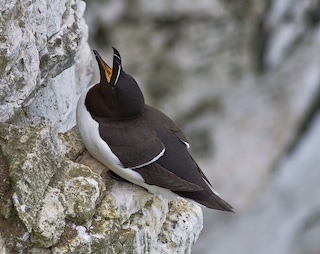 Although the largest Razorbill breeding colonies are in the north of Scotland, breeding pairs can be found in other parts of the UK. Outside the breeding season, they spend their life at sea – you may spot them flying past Lizard Point.
Although the largest Razorbill breeding colonies are in the north of Scotland, breeding pairs can be found in other parts of the UK. Outside the breeding season, they spend their life at sea – you may spot them flying past Lizard Point.
Photo: © Natural England/Allan Drewitt
Scientific name: Alca torda
Cornish name: Murr
Conservation status: IUCN Red List, Least Concern; UK Birds of Conservation Concern, Amber.
What to look for:
- Colouring and appearance : Seabird with black upper- and white underparts and thick black bill with a thin white line: a thin white line also extends between the bill and the eye. Outside of the breeding season, the throat and face behind the eye become paler and the white line less marked. Males and females have identical plumage, but the males are larger.
- Size : Wingspan 60 to 69 cm, length 38 to 43 cm.
- Where : North Atlantic distribution. Seen round the coastline, only coming to land to breed: at other times of year Razorbills live at sea. They breed round the British coast on steep cliffs, except along the south-east coastline between the Isle of Wight and Humber Estuary; the largest breeding colonies in Britain are in Scotland.
- Call : Not a very vocal species, but does produce a throaty ‘urrr’ in the breeding season, and an ‘arrc-arrc’ call.
- Similar species : The Guillemot, which is mainly distinguished by its thinner bill.
 The striking Razorbill, with its black and white plumage and handsome white-lined black bill, is only seen on land in the summer breeding season. A colonial seabird, the largest breeding colonies in the UK are in northern Scotland, but it does breed elsewhere, except along part of the eastern English coastline. Pairs mate for life, with the female laying a single large egg each year in a rock crevice or amongst pebbles on cliff ledges, with both parents sharing incubation duties. The young fledge after two to three weeks and then disperse. An agile flyer, Razorbills can also swim strongly underwater when hunting for their fish prey.
The striking Razorbill, with its black and white plumage and handsome white-lined black bill, is only seen on land in the summer breeding season. A colonial seabird, the largest breeding colonies in the UK are in northern Scotland, but it does breed elsewhere, except along part of the eastern English coastline. Pairs mate for life, with the female laying a single large egg each year in a rock crevice or amongst pebbles on cliff ledges, with both parents sharing incubation duties. The young fledge after two to three weeks and then disperse. An agile flyer, Razorbills can also swim strongly underwater when hunting for their fish prey.
 Outside the breeding season, Razorbills live out at sea. Sadly, many people’s experience of these birds onshore is not at breeding colonies but on television screens: Razorbills are among those species often washed ashore after major oil spills. They are also vulnerable to the industrial and agricultural pollutants that make their way into the ocean from rivers, and also to over-fishing by humans, which reduces food availability.
Outside the breeding season, Razorbills live out at sea. Sadly, many people’s experience of these birds onshore is not at breeding colonies but on television screens: Razorbills are among those species often washed ashore after major oil spills. They are also vulnerable to the industrial and agricultural pollutants that make their way into the ocean from rivers, and also to over-fishing by humans, which reduces food availability.
The British and Irish populations are internationally important, representing some 20% of global numbers. Summer numbers are swollen by migrants, but there is a resident population here. The Amber status in Britain is due to the localised nature of the important breeding colonies.
Did you know…?
…For a female Razorbill, laying the large egg is like a human giving birth to a 20 lb baby!
…The Cornish name, Murr, is probably derived from the deep throaty call of the Razorbill. The French name translates as Little Penguin, referring to the bird’s upright walk on land.
More information and references:
Svensson, L., Mullarney, K., Zetterstrom, D.,1986. Collins Bird Guide, second edition (translated by Christie, D., Svensson, L.). HarperCollins, London.
Published: August 2014
Author: Amanda Scott
Photos: © Natural England/Allan Drewitt
